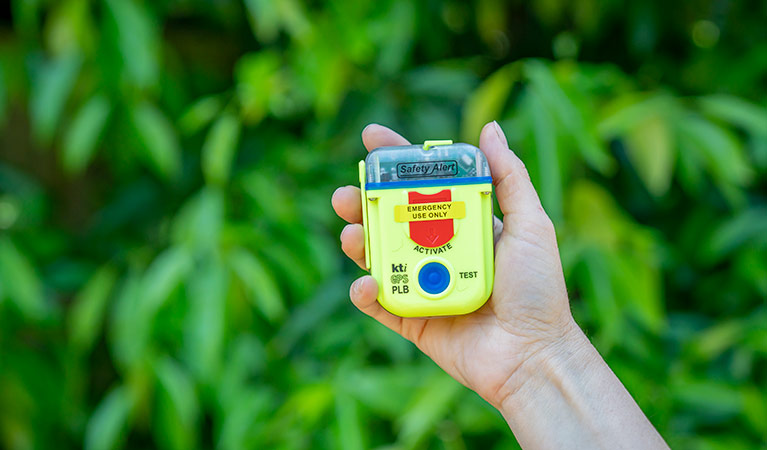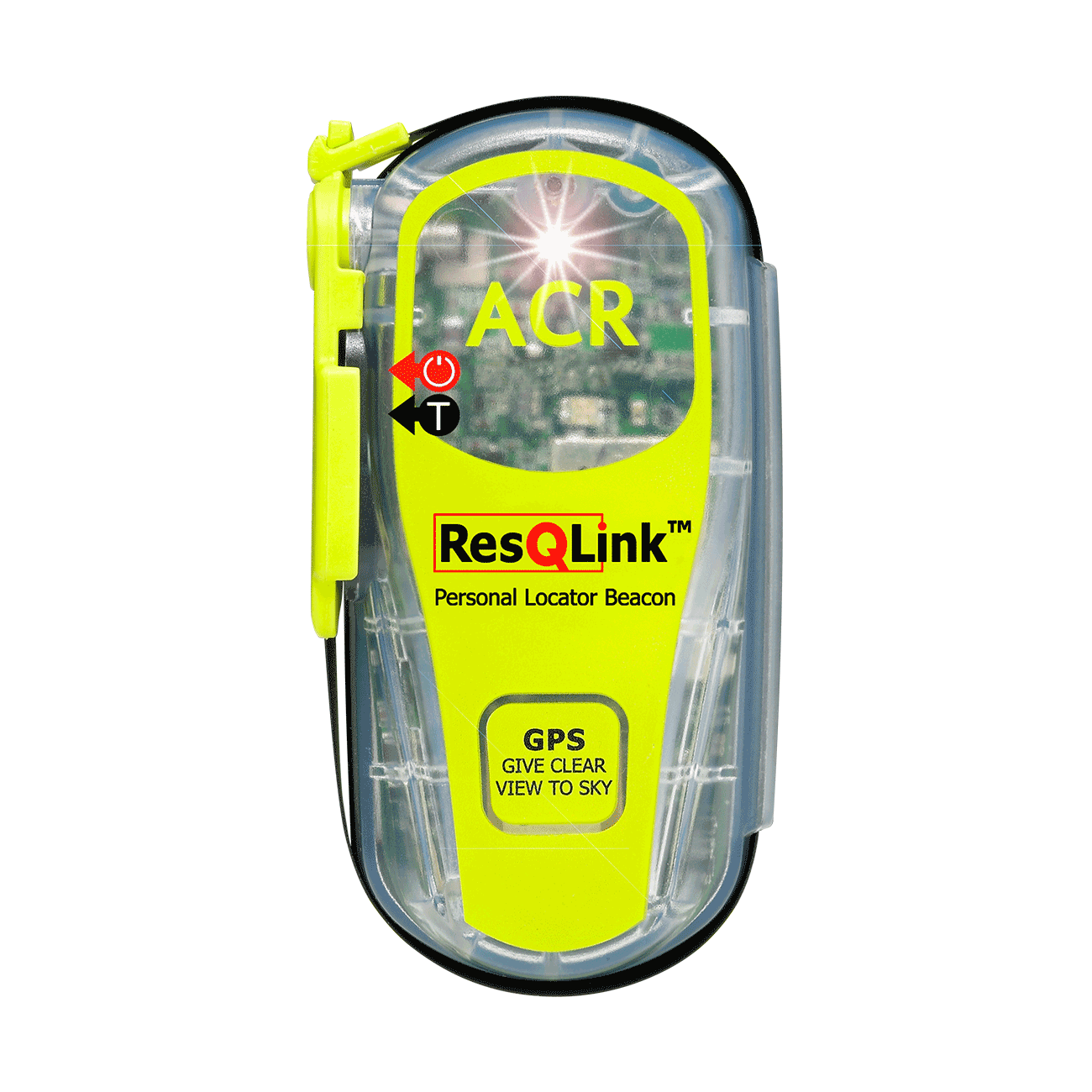The garmin inreach explorer+ is not a dedicated plb but rather a gps and personal locator beacon all in one. It allows two way communications with the
emergency
management centre however is dependant on being recharged. Emergency contact is initially though the usa who will then advise amsa of the issues. The garmin units are becoming more common throughout australia and is now my personal beacon choice.
 The downside of this type of unit is the initial purchase cost of aud $799rrp as well as the ongoing annual subscription service to operate. In my case my annual subscription fee sits just under $400 9which includes a couple of big hikes but for that my wife can follow me on my day/multi-week solo hikes by use of the online map.
The downside of this type of unit is the initial purchase cost of aud $799rrp as well as the ongoing annual subscription service to operate. In my case my annual subscription fee sits just under $400 9which includes a couple of big hikes but for that my wife can follow me on my day/multi-week solo hikes by use of the online map.
If you are shopping for an emergency beacon, you might be wondering what the difference is between an epirb (emergency position indicator radio beacon) and a plb ( personal locator beacon). The answer is that epirbs are meant to be installed or otherwise kept on a boat. They also require registration to a government database that ties them to a particular boat. Plbs also require registration, but instead of being registered to a boat, they are registered to a person, which gives users the ability to take their plb wherever they wish. Like epirbs, plbs operate on the 406 mhz and 121.
Due to australia’s large landscape and changing weather a personal locator beacon (plb) is an essential item for any person who is heading into the outback, bush walking, hiking, backpacking, 4wdriving and boating be it an afternoon trip or a multi-day trip. Beacons (also known as distress or emergency beacons) are the most effective way of letting people know that you need urgent help, and where to find you. Devices like zoleo , spot gen4 or even spot x can send ok messages that carry your gps coordinates to let family and friends know your ok. Zoleo has an extra feature, which allows you to send satellite sms messages from the zoleo app on your smartphone.
Reading time: 2 minutes a person al locator beacon (plb)* is a highly reliable and effective way to communicate a serious and dangerous situation to emergency services. A plb, when activated, sends the location and the device identity via emergency communication satellites and commercial aircraft. It is a one-way communication. A plb does not provide any information about the nature of the emergency. It should only be activated in a situation of grave and imminent danger – when faced with a life threatening situation. (* plbs are sometimes called epirbs, but the term epirb is now limited to emergency beacons for marine vessels.
Best PLB: ACR ResQLink View
The acr plb-350c aqualink view is similar in operation and simplicity to the resqlink+, but with the added feature of having a digital display so you can see all of the beacon’s activities. The display will show the gps coordinates, battery life and when transmission bursts are made. It will even give the user suggestions on use for sending the best signal.
 As with the resqlink+, use is extremely simple: deploy the antenna and hit the call button. Even if you lose consciousness, the unit will continue to transmit and guide rescuers into your location. This unit also has a strobe light to help rescuers.
As with the resqlink+, use is extremely simple: deploy the antenna and hit the call button. Even if you lose consciousness, the unit will continue to transmit and guide rescuers into your location. This unit also has a strobe light to help rescuers.
A plb is a an almost foolproof way to make sure search and rescue is on its way in an emergency – but is one beacon enough for your group? we recommend taking along at least one for every few people in your party, if not one per person. That way, if they one unit is involved in an accident or mishap, the other members of the party have the ability to activate a plb also. For complete technical specifications and detailed features see the resqlink page at acr.
The resqlink view is a personal locator beacon or plb for short. This little guy boasts three levels of signal technology: gps positioning 406 mhz signal 121. 5 mhz signal homing capability what does this mean to us? well, when you are in a jam, the resqlink view can quickly and reliably relay your position to a large network of search and rescue satellites, making a rescue possible. Despite looking fairly basic, the combination of 3 signal levels provides uncompromising location abilities. The resqlink view also has some great features such as a built-in strobe and infrared strobe to assist with nighttime or low visibility rescues.
Q: Do I need a personal locator beacon?
Emergency locator beacons are valuable tools to have on board during a boating, hunting, or hiking emergency. An emergency position indicating radio beacon (epirb), or a personal locator beacon (plb) are great ways to reach help in a search and rescue situation. Brands like acr, mcmurdo, and ocean signal all make exceptional emergency beacons that pinpoint a near exact gps location.
A personal locator beacon , or plb for short, is a personal electronic transmitting device that is designed to alert potential rescuers to a life-threatening situation in the air, on water or in remote areas. When activated, the plb sends out a signal on either a 406mhz frequency or local area system using 121. 5mhz, vhf dsc and/or ais. Example scenarios of when a plb may be required are: man overboard skier caught in a landslide hiker lost or trapped and unable to call for help helicopter ditching.
Choose between two market leaders, the mcmurdo fastfind 220 plb and the ocean signal rescueme plb1 plb - personal locator beacons or plbs are they are also known, are excellent items of personal safety equipment for sailing and all manner of ouddoor adventure.
What is a plb? a personal locator beacon (plb) is a persoanl electronic transmitter used to alert rescuers that there has been a life threatening man over board (mob) situation with a need to be rescued. When activated, the plb sends out a signal on either a 406mhz frequency or local area system using 121. 5mhz, vhf dsc and/or ais*. * this will depend on model. Force 4 guides:.
Q: How much are personal locator beacons?
Personal locator beacons can be hired from any of our new zealand stores (subject to availability). Visit the macpac store locator at macpac. Co. Nz/our-stores to find your nearest store.
A personal locator beacon takes the ‘search’ out of search and rescue. They’re compact, lightweight and, when compared to the potential cost of not carrying one, inexpensive. Gps and 406mhz all modern beacons transmit a 406mhz signal, but some also transmit the older 121. 5mhz signal to help searchers home in on your location once they arrive in the vicinity. Your chosen plb should also be gps-enabled so it can send your exact location to searchers. It is a legal requirement to register your plb with the rescue coordination centre new zealand (rccnz). There is no charge to do this and once completed, your plb’s distress signal will be linked to your personal information – name, address, emergency contact phone numbers, medical conditions – that can offer clues to your specific needs as well as speed rescue response time.
This article describes the various types of locating beacons in use, how and when they’re used, advantages and limitations, and current issues. First, let me define the different types of beacons or locators; three which apply and three that don’t. There is a new device called a recco reflector that is often discussed alongside new locating technologies. Popular in europe and growing in popularity here, these are tiny devices (passive diodes) that are sewn into clothing or built inside ski boots. A specialized recco detector transmits a signal which bounces back when the detector is pointed toward the reflector.
Lifejackets specifically designed to integrate a personal locator beacon (plb). Ultimate safety and rescue option. Mullion can equip your lifejacket with a beacon and/or supply the actual beacon.
Using Personal Locator Beacons
Personal locator beacons are worth it for outdoor enthusiasts, hikers, adventurers, and travelers. They provide a reliable and essential emergency communication tool, ensuring safety and peace of mind in remote or risky situations.
Plbs for bushwalking use are called personal locator beacons or plb. These are small, lightweight units suitable for bushwalking use. All 406mhz beacons should be registered. Registration is free and can be done here. Be aware that some overseas beacons are not compatible with the australian system. The safest way to avoid this problem is to purchase your plb from a reputable australian retailer, but if you wish to purchase internationally you must ensure the unit you are purchasing is compatible with the australian system. Further information on this issue can be found here. See the australian maritime services authority website for a more detailed information about the system and how to use it.
A personal locator beacon (plb) is a an emergency beacon to alert rescue authorites and to indicate the location and the identity of a person in distress. These beacons are designed to be carried by an individual person. A plb has to activated manually. Plbs operate on 406 mhz. The signal of a plb is detected by the cospas-sarsat satellite network anywhere in the world. The network passes the alert to the nearest rescue authority. The cospas-sarsat satellite network can detect the location of the plb with an accuracy of 2 to 5 km. Newer plbs can have a gps navigation receiver integrated into the distress signal.
Delivery & returns personal locator beacon plb rescueme 1. Compact plb being 30% smaller than most beacons it can easily be fitted into your lifejacket or onto your belt, ensuring always accessible, floating belt mount pouch included. Antenna deployment could not be easier, with only a gentle pull the aerial is released. Then by simple one handed activation the plb transmits on 406mhz your position and unique id to a rescue centre via satellite. Rescue services can then accurately locate and home in on you using the 121. 5mhz homing signal. Specifications: satellite transmission 406mhz 5 watt, homing transmission 121. 5hz, 50mw nominal.
No comments:
Post a Comment